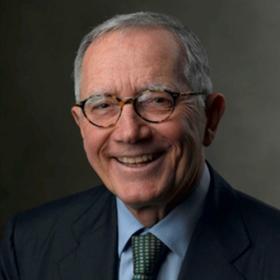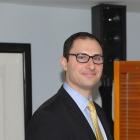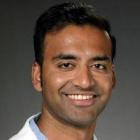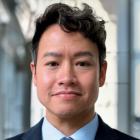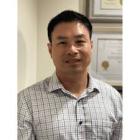Early career
One milestone most important to me occurred very early as a medical student in the Howe Laboratory on a rotation with the great neuro-ophthalmologist, David Cogan. At the end of that experience, I was asked to give a presentation of my choice. I decided on “Yttrium Implantation of the Pituitary Gland for Proliferative Diabetic Retinopathy.” (I was always good at presentations, a legacy from my high school experience at Arts High School in Newark, New Jersey. That presentation led to a couple of radio and TV appearances and a ticket to Harvard College.)
Unfortunately, there was always a missing element for such success—talent. (I should say, fortunately.) I made a very good presentation to Cogan, and he replied, “Nice presentation, young man, but a disappointing subject.” He was not impressed with the interventional surgical procedure and the ultimate outcome in the fundus. Cogan suggested I may have more of an interest in retina than neuro-ophthalmology. He also decided to introduce me to Charles Schepens, MD, the leader of retinal surgery in our country, if not the world, at that time. Schepens cordially invited me to revisit him after my residency. I never trained with him, but he did once try to recruit me to head the medical retina service at the Retina Foundation—a minor role in that distinguished group of vitreoretinal surgeons.
It was Franz Ingelfinger, MD, and Arnold Relman, MD, the successive editors of The New England Journal of Medicine, who tried to keep me in Boston to do a medical residency. However, when it came time, Cogan was set on my joining him at the Massachusetts Eye, Ear and Throat Hospital. He called on Carl Johnson, MD, who was running the residency, to find a place for me.
Johnson sent me to Carl Kupfer, MD, at the Howe Laboratory, who asked me, “What do you think of vitamin-A aldehyde?” with the intent of having me spend a year without pay to work in the lab. I replied, “Sir, I actually have never thought of vitamin-A aldehyde.”
Next, I was invited to spend a year editing the David Donaldson, MD, slides—a series of beautiful stereo images, mostly of the anterior segment of the eye. I replied, “But sir, I have been through those slides as a medical student.” At that time, I had no money or income, a small child, and another on the way. I learned that the residency started a new person every 3 months. So, after a year of research, I would have started the residency in 3 to 15 months or even later—no guarantee.
That is when I looked south to New York City, Manhattan Eye and Ear, and the New York Eye and Ear Infirmary, where I was welcomed to start immediately. It was tough to get a good ophthalmic residency then, as it is today. I think I chose MEETH because it paid a little more—about $5,000 a year. A good letter of recommendation from Cogan did not hurt. (Thank you, Dr. Cogan.)
Mid-career
My next meaningful experience happened as a second-year resident. A new diagnostic adjunct fluorescein angiography introduced in the clinical setting by Drs. Harold Novotony and David Alvis set the occasion for Donald Gass, MD, to describe new manifestations of known diseases and to discover new clinical entities.
Nothing proved more valuable than the inspiration offered by Gass legendary manuscript, “Pathogenesis of Disciform Detachment of the Neuroepithelium” in a 1967 supplemental issue of the American Journal of Ophthalmology. (I still have a signed copy by Don in my library at home.)
Prior to that manuscript, I had been stalking Don through his publications and presentations. Everything he introduced was via the Zeiss retinal fundus camera, the only commercially available system at that time. No such fundus camera was available at MEETH, but thanks to C.C. Tang, MD, a research scientist at the world’s first Eye Bank for Sight Restoration, founded by R. Townley Paton, MD, I was able to get my hands on an older model Zeiss camera—the “black body Zeiss fundus camera.” It was collecting dust in one of the Eye Bank’s labs on the 10th floor of MEETH.
For fluorescein angiography, the Zeiss fundus camera had at least 2 major limitations. First, the light source and electronic flash needed to be updated. The intensity of the flash required at least 3 seconds to recycle—too slow. Changes were needed to create sharply focused color photos of the fundus and to increase the recycling of the flash for fluorescein angiography photos to capture the perfusion of the retinal circulation.
Second, the advance of the film plane required the twist of a knob—too slow for perfusion. These 2 limitations were quickly addressed. The first was solved by adding a booster flash electronic device modified by a mechanic in his garage in Miami. My friendship with Johnny Justice Jr, Gass’s pioneering original photographer, assisted me in modifying the flash for $200, an amount awarded to me through the generosity of Herb Katzin, MD, a corneal surgeon doing research at the Eye Bank.
I had to mail the existing light system to Miami, and I was thrilled at the ability to recycle the electronic system every second at sufficient intensity. There was still the problem of rapid film advancement; this was mediated with an adaptor mounting ring and by substituting the Contech/Zeiss camera back with a Nikon SP rangefinder camera back, which had a thumb trigger mechanism for advancing the film.
Also important was the need for mutually exclusive filters to transmit excitatory light in front of the flash and to block excess reflected light or pseudo-fluorescence to the camera back—easily solved with Wrattan Kodak filters. These changes were supported by my weekly—or should I say, weakly—salary. I clearly remember the day when I was able to assemble these components into a working system for the first time, and to do a fluorescein study on an older gentleman with an optic nerve head melanocytoma.
(Don Shafer, MD, asked me whether it fluoresced. I replied, “I don’t know.”) There was a consent, but no code and no payment. I did the injection, the photographs, and the clean-up after the patient’s nausea and vomiting. (No, it did not fluoresce.) I started doing fluorescein angiograms on patients described by Don Gass and on others with macular disease that I poorly understood.
Later career
In the beginning, there was also a void in New York City—few other individuals were interested in fluorescein angiography. Paul Henkind, MD, was still in the United Kingdom, and Ronnie Carr, MD, was interested in electroretinal physiology. There were no other medical retina specialists, which left the teaching up to me.
Suddenly, the sole manufacturer of the fluorescein dye from Hillside, New Jersey, (Moore-Kirk Company), found that there was a demand for the dye that had been used only to measure circulation times. I had exhausted the fluorescein stock from neighboring institutions through our hospital pharmacy, and the company realized the need for expanding its production. They convinced Alcon to buy the dye.
Alcon used me, a resident, as a consultant because of the potential purchase of the drug from Moore-Kirk. The use of fluorescein dye was, in my opinion, an investigative procedure. I advised Alcon not to purchase the dye because it was not going to be needed for every ocular examination, as suggested by Moore-Kirk. Alcon went ahead anyway and paid $5 million for the Moore-Kirk license (a lot of money in those days).
I gave the same advice to the Smith-Miller and Patch Company. They were smart enough simply to formulate a 10% solution of 5 cc fluorescein, rather than a 5% solution of 10 cc—no FDA approval was needed at that time. Also, there was no consultation fee on my part beyond a small contribution to MEETH for the residency teaching program.
From that example, I learned how to raise money for teaching and research. I also learned to fundraise with control of the assets when the institution transferred these meager funds into the general funds of the hospital without my knowledge or consent. This was one of my motivating reasons for starting The Macula Foundation. I have since raised more than $52 million for this Foundation through angelic patients and friends, and I have used this funding to support fellows, teaching programs, and research.
I never learned to raise money from commercial interests. Even minor additions to patient care such as the “Yannuzzi Lens” or the “Yannuzzi Card” or one of my texts, like The Retinal Atlas, were not remunerative to me or to the Foundation, but I see no harm or conflict in accepting research and teaching support as long as no endorsements of products or devices are required. The take-home message: Keep the money you raise for teaching and research under your own control whenever possible.
Was there a time in your career when you witnessed history in the making?
I did witness ophthalmic history in the making, but I did not have much to do with it. I remember calling Judah Folkman, MD, after reading his classic 1971 article on anti-VEGF treatment of thoracic hemangiomas in the pediatric setting in The New England Journal of Medicine. In that article, he noted neogenesis is seen elsewhere in the body. There was no mention of the ocular fundus.
I told Judah Folkman that there were angiogenic diseases in the eye he may have overlooked, such as in age-related macular degeneration (AMD) and proliferative diabetic retinopathy. He thanked me and said he would discuss that with one of the investigators in his lab, Tony Adamis, MD, who was headed to an ophthalmology residency. Tony was also a best friend of one of our Vitreous-Retina-Macula Consultants of New York doctors, David Guyer, MD. (At their weddings, Tony was David’s best man, and David was Tony’s best man.)
David Guyer had a stellar background at Yale, Wilmer, and Harvard. He was at VRMNY on the recommendation of Stuart Fine, MD, the master of clinical trials, and Morton Goldberg, MD, the master of ophthalmology department development. I urged David to follow up on an anti-VEGF interest in California (with Wayne Fung, MD). The Macula Foundation supported David’s trip to Hoffman LaRoche on the West Coast to look into alpha-interferon, reported to be an effective anti-VEGF medication in neovascular AMD.
David interfaced with Denis O’Shaughnessy, PhD, and Gilead Sciences, Inc, and came home with the aptamer, which eventually became the first anti-VEGF drug, Macugen, to be approved for the treatment of neovascular AMD. David then became the founder and president of EyeTech, which produced Macugen, and Tony became the medical director of Genentech, Inc, leading the development of Lucentis.
Our office was involved with 2 trials—one investigating Macugen and the other, Lucentis. I was head of EyeTech’s medical advisory board briefly, until the company expanded. We all know the outcomes were both favorable, but Lucentis was the one to prevail. When Goodwin Breinin, MD, the long-standing chairman of ophthalmology at NYU, and Dean Robert Glickman, DMD, invited me to become chairman at NYU Ophthalmology, I convinced them that a younger and brighter guy, David Guyer, was more suited.
David left our group to become chairman at NYU. Tony Adamis became the head of medical/ophthalmology at Genentech. The take-home message: Thank you to both David and Tony for their contributions to the development of those drugs. That form of treatment was a game changer for us all.
What career accomplishment provides you with the greatest sense of satisfaction?
The polypoidal story was also a good milestone. It had to do with Reviewer #83 from the journal Retina. I had a series of patients who fit into the category of “hemorrhagic detachment in the posterior segment” described by others. These descriptions were in Black females, but my cases were also seen in Asians, Caucasians, and others.
There were suspected choroidal aneurysms with a second vascular component, branching, intervening vessels. These branching vessels on 3-dimensional examination apparently terminated in aneurysmal dilatations. They leaked and they bled. They even rarely pulsated like retinal arteriolar macroaneurysms. The polypoidal manuscript bounced back and forth to the journal Retina, and to its editor in chief, Sandy Brucker, MD.
I knew that reviewer #83 was Don Gass, my ego-ideal and close friend in the field. Finally, reviewer #83 said he would accept the paper, but we should change the name polyp. I replied that I agreed with reviewer #83, but I could not come up with a better name. I suggested that reviewer #83 propose a name. The reviewer replied that he could not think of a better name; so, we called it polypoidal.
The other reviewer (Alan Bird, MD) accepted the findings after his colleague and friend at Moorfields (Zendek Gregor) said he had seen such patients in their clinics from the British Caribbean. The take-home message: We still need better clinical pathological correlations. Those pulsating and leaking/bleeding lesions are more like the vascular complex seen with the glomerulus, but we still do not have a better name.
How do you imagine the practice of retina will change by 2040?
So, where are we headed in medical retina? Contrary to the belief of some, I think the front end of training will remain the same, at least for a while: medical school, internship, residency, and fellowships in ophthalmology. Those training landmarks may have internal revisions of their own, like the time period and required courses for graduation for selected specialists.
Focusing on the post-residency, however, there could be more immediate and dramatic changes. Some obvious modifications in medical care, like artificial intelligence and machine learning, are likely to have an impact on medical retina specialists. In contrast, telemedicine, while here to stay, will have a limited role until imaging devices provide a 360⁰ analysis of the fundus 3-dimensionally from aura to aura, and vitreous to sclera, with high definition of retinal and choroidal layers. It will be useful for meetings, even grand rounds.
Will we be able to acquire the resolution to identify cells infiltrating the vitreous, retina, choroid, or mass intraocular lesions? It may take time to provide the needed sensitivity and specificity, but why not? No, it will not happen in my generation, and probably not in the generation now entering the field. Will surgical retina spin off from medical retina, and will medical retina specialists spin off from the acquisitionists or technicians who simply do the imaging, like radiologists? It’s possible.
One change that will have to take place is in the purchase and use of evolving technology. Medical retina specialists will simply not be able to afford to purchase all of the necessary imaging modalities. Institutional and private equity groups will expand with intragroup mandatory or restrictive referrals. Solo practitioners will disappear.
In my 50 years of practice, the level of retinal innovation has been unpreceded in the history of ophthalmology. Pharmacotherapeutics, imaging and surgical innovations, and clinically designed research trials all have had a major impact on retinal care. Scientific discoveries will continue to expand to manage currently untreatable diseases.
Topical administration of drugs or genes may become easier. For sure, advances on editing the genome with CRISPR-like methods will be issued rationally. Prenatal treatment will expand with other forms of preventive care. All of these challenges will be met by a future generation of medical retina specialists.
A better understanding of the complete genome by genetic scientists will provide a clearer, complete understanding of how DNA influences disease risk. Future scientists will likely identify missing individual genes in DNA and decode their sequences—obliging institutions to obtain the technology, technicians to acquire the images, physicians to diagnose patients, and medical and surgical retina specialists to treat them.
Maximized patient engagement, especially in preventive care, will form new standards of data-driven health care. Another speculation involves the medico-economic side of patient care. Who will pay for the training, technology, diagnosis, and treatment? Those questions will be left to future regulatory figures. To get the administrators of eye health care to agree may be more difficult than in the past for most evolving issues.
Can you share any advice for future generations of retina specialists?
During my career, my passion has always been for teaching and conducting research while maintaining an active role in clinical care. I firmly believe that one cannot do good clinical research without solid clinical experience. So, no matter what the advances will be, I urge physicians to find time for teaching and research. The teaching end of it will offer rewards beyond personal satisfaction. You will discover new and lasting friendships as I did—worldwide.
Our sincere thanks to Dr. Yannuzzi for sharing his retina reflections.
